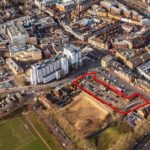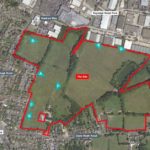Living near Jeremy Clarkson’s Diddly Squat farm, Dan Lampard, senior director and head of Thames Valley for Lichfields, found the complex planning issues around it a compelling subject for family discussion. Here, he explains in detail the merits of one of the most well-publicised planning wrangles.
Vociferous debates around television viewing in the Lampard household usually revolve around which channel to watch – or when anyone taunts me by supporting a football team other than Arsenal.
Over the Spring, for the first time, the whole family debated the merits of town planning as we all watched Jeremy Clarkson’s highly entertaining efforts to run Diddly Squat farm. We live near the farm, know some of the suppliers benefitting from the incredible success of the farm shop, and one of my children’s teachers made a cameo appearance as a member of the planning committee – so we were all entrenched in our positions.
The majority view was that during hard times, for farmers in particular, the council should be celebrating the success that Clarkson’s regeneration of the farm was bringing about. Conversely, being something of a Clarkson-sceptic and having been stuck in traffic jams caused by visitors to his farm shop I felt some professional sympathy with my town planning brethren in resisting this.
Many of the issues our family argued about were expanded upon in a recent appeal hearing in West Oxfordshire and the decision – something of a score draw – was released last week. Having read in the Witney Gazette that extra security measures were in place at the appeal, given the controversy – including death threats – that had arisen, I’m glad that our family disagreements were more controlled
The appeal decision, one of the most prominent in recent years, warrants analysis as to how such an extraordinary level of interest was generated and how planning can work through such divergent views.
In the beginning . . .
Clarkson owned the farm for a number of years before his collaboration with Amazon but generated little controversy. The whole farm is within the Area of Outstanding Natural Beauty (AONB) – forming a significant constraint in planning policy terms.
The current story begins when West Oxfordshire District Council (WODC) granted permission in 2019 for ‘a lambing shed and farm shop, including car parking and associated access’.
The application (submitted anonymously – ‘c/o agent’) raised few concerns (and none around the 10-space car park) with WODC officers concluding these works ‘would not have a significant harmful impact [on the AONB]’.
Their economic team concluded the proposals offered ‘important investments to allow the farm business to diversify as its reliance on subsidies inevitably reduces’.
Perhaps the only clue to future controversies was that the planning permission also encompassed ‘potential for occasional film-making’.
Fast forward a few months and the farm shop opened. The series records Clarkson eschewing traditional advertising and instead, tweeting his followers – with traffic Armageddon following. One of our friends made her TV debut in the inaugural traffic jam – telling Clarkson she was visiting the farm shop with her sick husband having just collected him from hospital – as you do.
The following couple of years, despite much of it being in Covid lockdown, led to further attempts by Clarkson to expand the economic base of his farm (sometimes without planning permission – as the subsequent enforcement action attests) with further traffic chaos resulting Clarkson himself, observing the traffic chaos and fast dissolving highway verges despaired to the camera: “I just didn’t think this through.”
The decider
These ongoing tensions culminated (for now) in a two day appeal hearing in Witney in March – with the appeal decision being released recently.
Unlike the rest of the series, the appeal hearing may not make compulsive viewing outside the town planning and transport planning fraternity, since there are likely to be too many references to planning units, primary uses and functional and physical relationships to boost the ratings.
In his decision, the inspector grappled with four main considerations. All of these arose from his observation that many of the issues stemmed from ‘the popularity of the appellant, Mr Clarkson, who is a well-known journalist and presenter’ and that, as a result, ‘Diddly Squat has become a destination for visitors from all over the world’.
Specifically, he considered:
- Appropriate uses other than agriculture : The inspector commented on the farm’s incredible popularity with visitors, including the trend for them to take ‘selfies’ – surely the first reference to these in an appeal decision. The uses present go far beyond the permitted agriculture, farm shop and lambing shed. The latter, he commented, is not generally a place where ‘one would normally sit to eat food, selected from a more than basic bar menu . . . or drink beer pulled in the same way as your local pub’. – not surprisingly he concluded it had ‘changed from the use for which it was given planning permission’.
- Transport harm : The inspector concluded that ‘this is not an ordinary farm shop, given the occupation and high profile of the appellant’. The 10-space car park was never going to be sufficient and unsurprisingly ‘parking has spilled onto the adjacent land’. Somewhat mildly he referred to the car park as being ‘oversubscribed’ with knock-on effects including parking on (and damage to) verges resulting in a ‘huge inconvenience for those who live nearby’.
- Harm to AONB : Planning policy is clear that the scale and extent of development within an AONB should be limited. In his analysis, the inspector noted the volume of cars, signage, outdoor seating, catering vans and restaurant, which he concluded ‘has had a deleterious effect upon the character and appearance of the AONB and the tranquillity that planning policy seeks to protect’.
- Economic benefits : Conversely, he went on to recognise that the ‘farm shop has been very successful’ and had ‘undergone a radical transformation in less than three years from a farm shop to a tourist destination’.Whilst some harm had arisen from these uses in a sensitive location he was in ‘no doubt that that the farm shop and other activities have contributed to the local economy’ and these ‘benefits are set against the background of any previous agricultural subsidies coming to an end’.
The result is in . . .
It fell to the inspector to adjudicate in a context where the sheer popularity of an enterprise had left the planning system struggling to assess and then control it.
As with all planning decisions the inspector weighed all policy and other matters in the round – specifically the clear harms which he had identified against the ‘benefits to the local economy, employment, farm diversification and agriculture’.
Clarkson fell short of getting all he was seeking although the inspector suggested some sympathy at his ability to reduce the attractiveness of the farm to visitors noting he ‘could not stop the volume of customers arriving lawfully at the site save for closing the enterprise altogether’. He also sensed that, in future years the farm’s popularity may wane, noting there was ‘a lack of clarity over how long the successes of the farm shop will continue’.
Overall, and in the spirt of balance, he concluded that ‘a new car park would reduce the adverse effects of the current parking situation on the AONB and upon highways safety’ but would not see a complete end to parking off site and that a temporary solution would be appropriate to ‘limit the use to a period of three years and requiring restoration of the site following that period’.
In the same spirit of short-termism, he also permitted the use of the lambing barn as a café for three years but refused the other elements – most notably the restaurant.
The Lampards are looking forward to Series Three already.
© Thames Tap (powered by ukpropertyforums.com).
Sign up to receive our weekly free journal, The Forum here.

















Thanks Dan for making this clear and readable.
Thank you for a well written piece. Being a Norwegian I do feel for Mr Clarkson’s in his fight against local government who talk about the importance of developing local business, when they in reality have no idea how to do it or the will to do it. Maybe they just want pensioners? I know a few farmers who are constantly fighting to make their farms more profitable, but are hampered by regulations on how many sheep they can have, if they can produce cheese, beer (not legal in Norway) not based on how much their farm can support but on the needs of Norway instead. (Farmers get a lot of grants, but the government sets the price a farmer can for a lot of their produce)
If it was anybody but clarkson he would of been approved its just a vendetta against him. He was helping other farmers in the area. You even refused a farm track on his own land. Just pure jealousy from the so called do gooders in the area. He worked really hard on that farm and was genuinely trying to make it work. I wonder how many other farms in the area was refused planning permission. Im guessing none. Tossers
A local farmer in Warwickshire had a track made on his farm by the highways authority when they built another bridge and roundabout over the M40 motorway so that they could spread the spoil from the excavation on his land
After all was completed everyone was happy with the new flyover and the farmer with his new track around his land.
Until the local council said that the track was a temporary messure and had to be removed.
Which it was!!
Mr. Clarkson you are not the 1st.
Well written and clarified Dan. As the inspector pointed out, the popularity might wane over the years and all calm down and become a steady enterprise and still benefitting the local producers. As regards an AONB, I think most of our beautiful countryside falls into that category. As long as projects are built and run sympathetically then it should not be a problem, more than could be said for a lot of developments that litter our country. (Steve Clarke from BEAUTIFUL Devon that’s suffering from TOO much development).
Pretty shocking behaviour from the local planning committee. They have prioritised the minority impacted AONB over the economy and livelihoods of those living nearby. As mentioned by others, this would be approved if anyone other than Clarkson. Despite he’s persona, he does genuinely care for the environment and farming is clearly a passion he has. Its really clear that the positives outweigh the negatives by a long way here.
Anyone else apart from Clarkson would have been passed planning he genuinely wants to help other producers in the area .the planning council should be ashamed of themselves. Let’s hope now that those producers will get help now off Clarkson.Hes highlighted the stupid rules farmers go through .here where I live farm shops with cafes are in abundance ..selling local produce ..
Cakes made locally ..
Laws are laws. If you were a resident in sny of yhe surrounding villages you may not be do supportive of Clarkson snd his celebrity status.
I gear Clarkson’s TV image of a brash over spoken bigot is actually not his TV personality. It’s Johnsonesque that he feels victimised.
To be honest if he had not had this “cult of icon” around him based in his TV success he may well not have been able to afford to stand up to the legal costs that legal challenges have bought.
3 years is a good bellwether as to the success or failure of his venture let us see. However the “it’s mine I’ll do what I want” attitude is not at all satisfactory.
I don’t know the man, am not that local I have no axe to grind – but I do know the area – it is beautiful and I’d imagine living with this volume of traffic and disruption would not be welcome.
WODC have been hammered over this but when Councils take on planning objections to big corporates especially retailers they often cave to costs. They do need commending on this for standing by their guns. That is after all why the public appointed them !
The district council is full of retired business people with no experience of the problems that farmers have to face.Clarkson is highlighting these issues and is fully supported by farmers all over the country.West Oxford district council is a disgrace;as was mentioned in the series no farmer has ever been prosecuted for laying a drive on his own land except for Clarkson!
The district council is full of retired business people with no experience of the problems that farmers have to face.Clarkson is highlighting these issues and is fully supported by farmers all over the country.West Oxford district council is a disgrace;as was mentioned in the series no farmer has ever been prosecuted for laying a drive on his own land except for Clarkson!